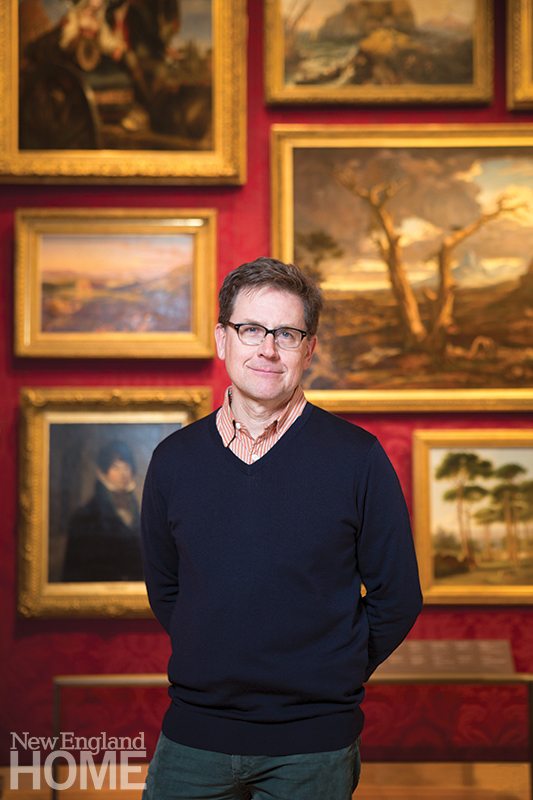Five Questions: Andrew Haines
March 29, 2018
When it comes to artwork, the oft-overlooked frame deserves attention, too, says Andrew Haines, associate conservator at Boston’s Museum of Fine Arts.
Text by Robert Kiener
 1. You are the MFA’s first conservator of frames. What do you do?
1. You are the MFA’s first conservator of frames. What do you do?
I am responsible for the “care and feeding” of the museum’s collection of some 5,000 frames. In sweeping terms, you can assume that, on any easel painting made in the western tradition before 1950, you can expect to find a frame. The first thing we do is look at the original frame and assess whether we should work with it (by doing repairs or removing old repairs) or find a replacement. If it’s too visually distracting, unsafe for the art, or inappropriate for some other reason, then a new one may be necessary. When this is the case, I do research both in our collection and from many other outside sources to see if the artist or his collectors had a particular taste in frames.
2. How have frame styles changed throughout art history?
Framing follows the decorative arts. Generally, ornate, carved frames began to be replaced by the end of the eighteenth-century when less expensive composition, or “compo,” frames came into favor. In the middle of the nineteenth-century, the Arts and Crafts movement got away from composition frames, in favor of ones that showed joinery and displayed the wood grain. Modernism basically destroyed the frame, with artists favoring the simplest bare bones structure; for example, Georgia O’Keeffe put thin metal strips around her paintings. In the post-Modernist era, the frame becomes almost nothing. In many 1960s and 1970s paintings, the frame is just a tiny wooden strip or it has become part of the piece.
3. Is the importance of framing sometimes an afterthought for art owners?
That is true, the frame is often considered to be the tail of the dog. However, because paintings are three-dimensional objects, the frame is important; you will always need some kind of surround. The frame affects the way you perceive an artwork. A good frame can “bump up a painting.” And because it’s a custom-made object it can be expensive. I’ve often heard, “I paid more for the frame than I did for the artwork,” but a good frame always enhances one’s appreciation of the art object. Having said that, the frame should not upstage the painting. Generally you won’t necessarily notice it unless you are someone—like me—who does.
4. What advice can you offer collectors looking to show their art to its best advantage?
The first thing I would say is do not necessarily be in a hurry to throw away the frame that the object comes to you with. It can be great to have a 100-year-old frame on a 100-year-old artwork. But the frame may also have nothing to do with the object, so it may be perfectly appropriate to get rid of it. It is important to get good advice, so ask for a recommendation from an art dealer, a framer, or even a museum. If the piece has a new frame, it is always a good idea to ask a dealer if they still have the original. Often it is more suitable.
5. What can a frame tell us about a painting?
Paintings and frames are separate objects and have separate lives. There is a long history of collectors changing frames, and the story of the frame is generally about the life of the painting after it leaves the artist’s studio. For an example, the MFA’s Bandits Leading Prisoners is a seventeenth-century Dutch landscape by Jan Both that hangs in a late eighteenth-century British Neoclassical frame. A wealthy Londoner had commissioned Robert Adam to design a room for his large collection of Dutch paintings. Presumably, the paintings originally had black ebonized frames typical to the time and place they were made. Adam proposed frames that were contemporary to late eighteenth-century London, thus showing off the keen eye and excellent taste of his client. I’ve compared frames to First Ladies: it is the job of the President’s wife not to be the center of attention. However, if you take the time to look at them closely, they will tell you a lot about their partner and they have an influence on how we perceive them.
Museum of Fine Arts, Boston, 617-267-9300, mfa.org
Share
![NEH-Logo_Black[1] NEH-Logo_Black[1]](https://b2915716.smushcdn.com/2915716/wp-content/uploads/2022/08/NEH-Logo_Black1-300x162.jpg?lossy=1&strip=1&webp=1)







You must be logged in to post a comment.